
views
Casting On a Foundation Row

Make a slip knot and slip it onto a peg. Take your yarn and make form a loop to make a slip knot. Slide the knot onto a peg on your loom. If your loom has an anchor peg, place it on a peg that's closest to the anchor. If your loom doesn't have an anchor peg, you'll just need to keep track of where you started the row. Place the slip knot on any of the pegs.

Wrap the yarn counter-clockwise if you're knitting clockwise. Use your right hand to pull the working yarn towards the center of the loom. Then wrap the yarn counter-clockwise around the peg that's next to it going in a clockwise motion. Keep wrapping the yarn around each peg until you've gone around the loom. Work clockwise if it's more comfortable for you. The lines of yarn should be closest to the inside of the loom if you've wrapped the pegs correctly. If your pattern calls for making knit stitches first, wrap another row of yarn around each peg so you have 2 levels of yarn on the pegs.

Wrap the yarn clockwise if you're knitting counter-clockwise. If you prefer to knit counter-clockwise around the loom, wrap the yarn around each peg in a clockwise motion. Continue in the clockwise motion around each peg until you've gone around the loom. The line of yarn should be nearest to the inside of the loom and you'll end up with 2 distinct lines on each peg. If you're knitting the first row, wrap the yarn around each peg of the loom 1 more time so you have 2 levels of yarn on each peg.

Use knit and purl stitches to work a loom project. Once you've established your foundation row, you can wrap the loops around the loom again in order to make knit stitches. You can also begin wrapping and lifting stitches in order to make purl stitches. Follow pattern instructions to craft your own projects using a combination of these stitches. If you're just learning, consider choosing a project that only uses knit stitches. Then you can begin adding purl stitches once you're comfortable with working on a loom.
Making the Knit Stitch
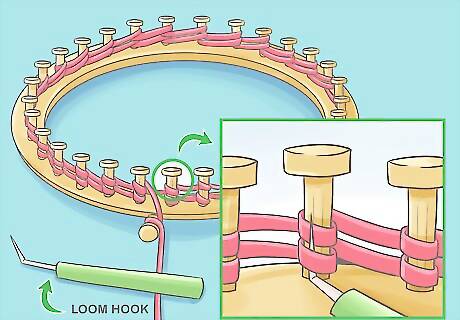
Insert a loom hook into the lower loop. Take a loom hook and insert the tip under the bottom loop of a peg. The hooked portion of the hook should catch on the yarn so it doesn't slip off. If you're concerned that your working yarn will come loose, wrap it around the anchor peg to secure it while you knit.
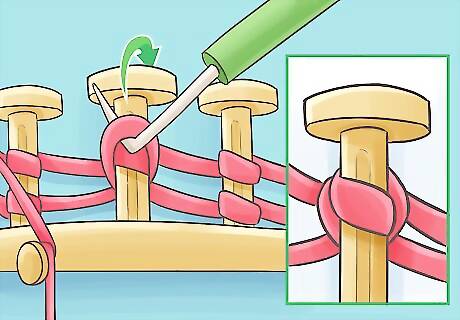
Pull the bottom loop up over the top loop on the peg. Bring the loom hook up and over the top of the peg. This will bring the bottom loop over the top loop on the same peg. Now you can take away the loom hook to use on the next peg. Avoid pulling the stitches too tightly or it will be difficult to bring the bottom loops over the top loops.

Repeat the knit stitch for the next peg or according to your pattern. Continue to knit each peg on your loom if you're making a garter stitch. If your pattern calls for some knit stitches and some purl stitches, follow its instructions. To make the garter stitch, knit every row.
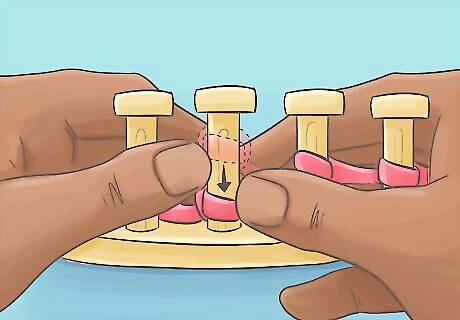
Push down the stitches to make room on the pegs. Once you've knit the first row on your loom, use your fingers to push the knit stitches down towards the base of the loom. If you're making a row of knit stitches, wrap the yarn around each peg as you did when you cast on the foundation row and work the stitches. If you'll be making purl stitches, you don't need to wrap another row. Keep track of how many rows you've made, especially if you don't have an anchor peg to use as a reference.
Making the Purl Stitch

Hold the working yarn in front and below the loop on a peg. If you're going to make purl stitches, you don't need to wrap another row around the pegs. Instead, bring the working yarn in front of the loom away from the center. Hold the yarn below the loop on the peg you're ready to work. You'll need the working yarn below the loop so you can pull it up and through the loop.
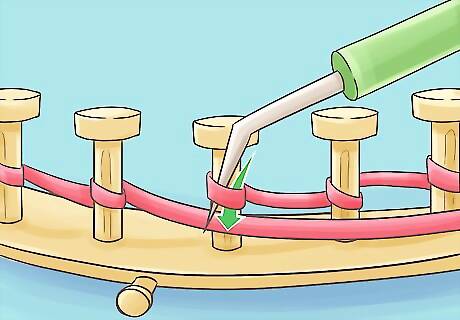
Insert the loom hook through the loop down toward the working yarn. Point the tip of the loom hook down and behind the loop on your peg. Push the loom hook through the stitch so the loop catches on the hook. It may help to guide the hook through the groove on the peg.
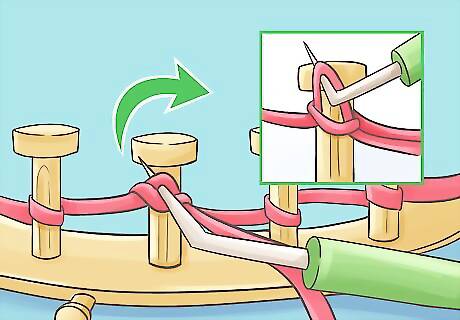
Twist the hook to catch the working yarn and bring it up. Turn the working hook so the tip points up and hooks onto the working yarn that's below the loop. Pull the working yarn up so it makes a loop. Avoid pulling the loop so it's a lot larger than the peg.
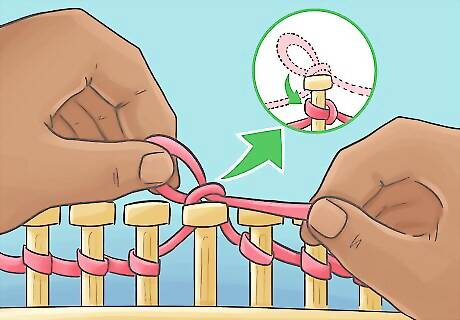
Remove the purl stitch and slide the loop onto the peg. Keep the loop on the end of your loom hook and pull it up so any of the stitches on the peg are lifted off. Then take the loop you just made and push it onto the peg. It should now be the only loop on the peg and you can bring the working yarn down below the next peg to make another purl stitch. If it's easier, use your fingers to lift the stitches off of the peg before you place the purl stitch loop onto it.
Binding Off

Cut the yarn to leave a 2 feet (61 cm) tail and thread it onto a needle. When you're ready to bind off your work, cut the working yarn and leave a long enough tail to sew the end shut. You'll need to leave about 2 feet (61 cm) of yarn for most projects. Then thread the yarn onto a tapestry needle. Ensure that you only have 1 loop on each peg before you begin binding off.

Insert the needle under a loop on a peg. Take the tapestry needle with the yarn and place it under the loop on a peg. The tip of the needle should be pointed up towards the top of the peg. If you don't have a tapestry needle, you can use a flexible plastic needle.
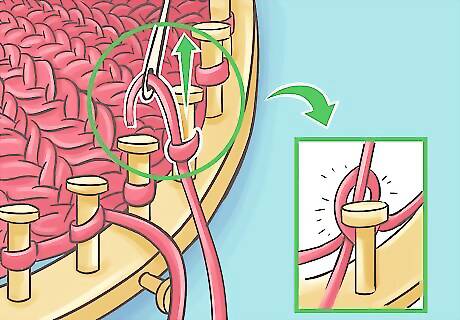
Bring the threaded needle through the loop and pull it off. Keep pulling up on the yarn so all of it is worked through the loop on the peg. Once you've pulled it all through, use your fingers to lift the loop off of the peg. At this point it's fine to drop the loop towards the center of the loom because it won't unravel.
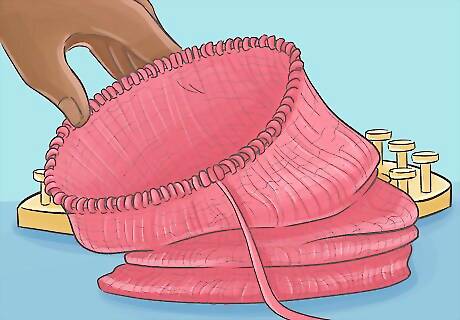
Bind off every loop around the loom. Continue to bring the threaded needle through each loop and pull off each stitch. Work your way around the loom and bind off the loop from the final peg. Now you should be able to remove the fabric from the loom because it's not connected at all to any of the pegs.
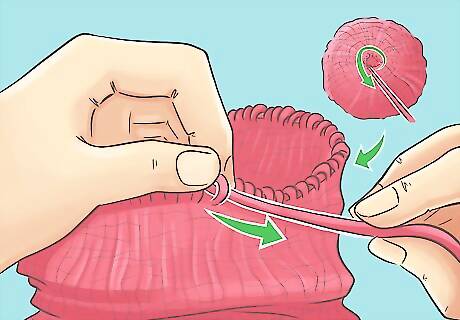
Pull and gather the fabric to secure it. Hold onto the loop that's next to the working yarn and use your other hand to pull the working yarn. You should see the fabric begin to gather and tighten. Once you've pulled it as tightly as you'd like, insert the needle into the nearby loop and make a knot. Now you can cut the tail and weave in the ends.
Choosing a Beginner Project

Make a basic hat using the knit stitch. Select bulky yarn that's comfortable and cast on a foundation row. Knit every stitch and then bind off the fabric. The knitted material will look like a tube. Then you can thread the end and pull it tightly to gather it together. Stitch on a pom pom to secure the end. To make a smaller hat, knit a smaller tube before gathering one end.
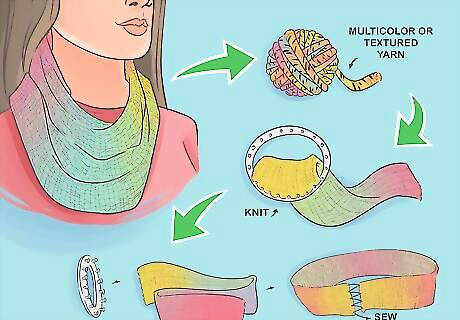
Use the knit stitch to make an infinity scarf. Choose a yarn in your favorite color and texture. Cast on a foundation row and then knit every row until the scarf is as long as you like. Bind off the fabric and sew the ends together to make an infinity scarf. For a multi-colored scarf, use several yarns or a single yarn that's been dyed multiple colors.
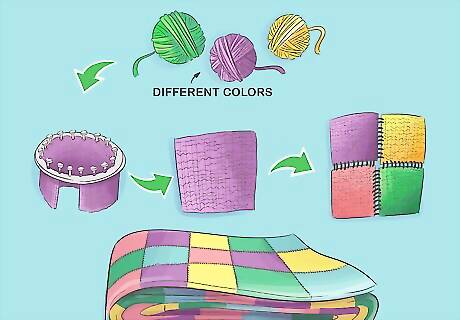
Work a garter stitch to make a blanket. Once you're comfortable with knitting and purling, work a combination of rows to create a garter stitch. Make blocks of fabric and stitch them together to form a blanket in any size. To make a multi-colored blanket, use a different color of yarn for each square.
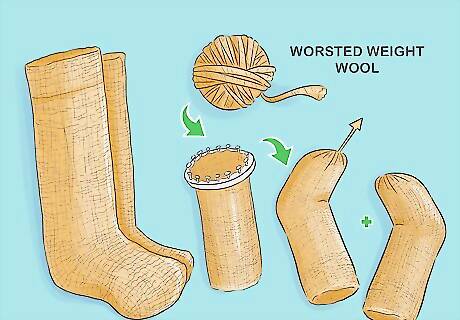
Create easy tube socks. Socks are notoriously tricky to knit with needles, but they work up quickly on a loom. Use worsted weight wool and work a combination of knit and purl stitches to make a sock. Bind it off and then gather the end to form the toe end. Make another sock and enjoy your hand-knit tube socks. Remember to follow the pattern closely so the socks are identical.




















Comments
0 comment